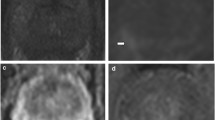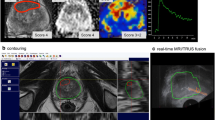Abstract
Objectives
To measure the performance characteristics of combined T2-weighted (T2W) and diffusion-weighted (DW) magnetic resonance imaging (MRI) suspicion scoring prior to MR-transrectal ultrasound (TRUS) fusion template transperineal (TTP) re-biopsy.
Methods
Thirty-nine patients referred for prostate re-biopsy, with prior MRI examinations, were retrospectively included. The MR images, including T2W and DW-MRI, had been independently evaluated prospectively by two radiologists using a structured scoring system. An MR-TRUS fusion TTP re-biopsy was used for MR target and non-targeted biopsy cores. Targeting performance and correlation with disease status were evaluated on a per-patient and per-region basis.
Results
The cancer yield was 41 % (16/39 patients). MR targeting accurately detected the disease in 12/16 (75 %) cancerous patients and missed the disease in 4/16 (25 %) patients, all with Gleason 3 + 3 disease. There was a significant relationship (P < 0.01) between MR suspicion score and the significance of cancer. Reader 1 had significantly higher sensitivity in the transition zone (TZ; 0.84) compared with the peripheral zone (PZ; 0.32) (P = 0.04). Inter-reader agreement was moderate for the PZ and substantial for the TZ.
Conclusions
MRI targeting is beneficial in the setting of TTP MR-TRUS fusion re-biopsy and MR suspicion score relates to prostate cancer clinical significance. A T2W and DW-MRI structured scoring system results in good inter-reader agreement in this setting.
Key Points
• Pre-biopsy MRI aids the detection of high significance cancer during prostate re-biopsy.
• MRI suspicion level correlates with the clinical significance of prostate cancer detected.
• T 2 W and DW-MRI structured scoring of pre-biopsy MRI permits good inter-reader agreement.




Similar content being viewed by others
References
Jemal A, Bray F, Center MM, Ferlay J, Ward E, Forman D (2011) Global cancer statistics. CA Cancer J Clin 61:69–90
Cooperberg MR, Broering JM, Kantoff PW, Carroll PR (2007) Contemporary trends in low risk prostate cancer: risk assessment and treatment. J Urol 178(3 Pt 2):S14–S19
Levine MA, Ittman M, Melamed J, Lepor H (1998) Two consecutive sets of transrectal ultrasound guided sextant biopsies of the prostate for the detection of prostate cancer. J Urol 159:471–475, discussion 5-6
Bott SR, Henderson A, Halls JE, Montgomery BS, Laing R, Langley SE (2006) Extensive transperineal template biopsies of prostate: modified technique and results. Urology 68:1037–1041
Bittner N, Merrick GS, Andreini H et al (2009) Pre-biopsy PSA velocity not reliable predictor of prostate cancer diagnosis, Gleason score, tumor location, or cancer volume after TTMB. Urology 74:171–176
Dimmen M, Vlatkovic L, Hole KH, Nesland JM, Brennhovd B, Axcrona K (2012) Transperineal prostate biopsy detects significant cancer in patients with elevated prostate-specific antigen (PSA) levels and previous negative transrectal biopsies. BJU Int 110(2 Pt B):E69–E75
Pal RP, Elmussareh M, Chanawani M, Khan MA (2012) The role of a standardized 36 core template-assisted transperineal prostate biopsy technique in patients with previously negative transrectal ultrasonography-guided prostate biopsies. BJU Int 109:367–371
Pinto PA, Chung PH, Rastinehad AR et al (2011) Magnetic resonance imaging/ultrasound fusion guided prostate biopsy improves cancer detection following transrectal ultrasound biopsy and correlates with multiparametric magnetic resonance imaging. J Urol 186:1281–1285
Hambrock T, Hoeks C, Hulsbergen-van de Kaa C et al (2012) Prospective assessment of prostate cancer aggressiveness using 3-T diffusion-weighted magnetic resonance imaging-guided biopsies versus a systematic 10-core transrectal ultrasound prostate biopsy cohort. Eur Urol 61:177–184
Moore CM, Robertson NL, Arsanious N et al (2013) Image-guided prostate biopsy using magnetic resonance imaging-derived targets: a systematic review. Eur Urol 63:125–140
Hambrock T, Somford DM, Hoeks C et al (2010) Magnetic resonance imaging guided prostate biopsy in men with repeat negative biopsies and increased prostate specific antigen. J Urol 183:520–527
Park BK, Lee HM, Kim CK, Choi HY, Park JW (2008) Lesion localization in patients with a previous negative transrectal ultrasound biopsy and persistently elevated prostate specific antigen level using diffusion-weighted imaging at three Tesla before rebiopsy. Invest Radiol 43:789–793
Vourganti S, Rastinehad A, Yerram NK et al (2012) Multiparametric magnetic resonance imaging and ultrasound fusion biopsy detect prostate cancer in patients with prior negative transrectal ultrasound biopsies. J Urol 188(6):2152–2157
Hoeks CM, Schouten MG, Bomers JG et al (2012) Three-tesla magnetic resonance-guided prostate biopsy in men with increased prostate-specific antigen and repeated, negative, random, systematic, transrectal ultrasound biopsies: detection of clinically significant prostate cancers. Eur Urol 62:902–909
Franiel T, Stephan C, Erbersdobler A et al (2011) Areas suspicious for prostate cancer: MR-guided biopsy in patients with at least one transrectal US-guided biopsy with a negative finding—multiparametric MR imaging for detection and biopsy planning. Radiology 259:162–172
Sonn GA, Natarajan S, Margolis DJ et al (2013) Targeted biopsy in the detection of prostate cancer using an office based magnetic resonance ultrasound fusion device. J Urol 189:86–91
Schwab SA, Kuefner MA, Adamietz B et al (2013) MRI-guided core biopsy of the prostate in the supine position-introduction of a simplified technique using large-bore magnet systems. Eur Radiol 23:1415–1419
Hadaschik BA, Kuru TH, Tulea C et al (2011) A novel stereotactic prostate biopsy system integrating pre-interventional magnetic resonance imaging and live ultrasound fusion. J Urol 186:2214–2220
Arumainayagam N, Ahmed HU, Moore CM et al (2013) Multiparametric MR imaging for detection of clinically significant prostate cancer: a validation cohort study with transperineal template prostate mapping as the reference standard. Radiology 268:761–769
Barentsz JO, Richenberg J, Clements R et al (2012) ESUR prostate MR guidelines 2012. Eur Radiol 22:746–757
Kuru TH, Wadhwa K, Chang RT et al (2013) Definitions of terms, processes and a minimum dataset for transperineal prostate biopsies: a standardization approach of the Ginsburg Study Group for Enhanced Prostate Diagnostics. BJU Int 112:568–577
Kuru TH, Roethke M, Popeneciu V et al (2012) Phantom study of a novel stereotactic prostate biopsy system integrating preinterventional magnetic resonance imaging and live ultrasonography fusion. J Endourol 26:807–813
Obuchowski NA (1997) Nonparametric analysis of clustered ROC curve data. Biometrics 53:567–578
Landis JR, Koch GG (1977) The measurement of observer agreement for categorical data. Biometrics 33:159–174
Chun FK, Epstein JI, Ficarra V et al (2010) Optimizing performance and interpretation of prostate biopsy: a critical analysis of the literature. Eur Urol 58:851–864
Kuru TH, Roethke MC, Seidenader J et al (2013) Critical evaluation of MRI-targeted TRUS-guided transperineal fusion biopsy for detection of prostate cancer. J Urol 190:1380–1386
Puech P, Potiron E, Lemaitre L et al (2009) Dynamic contrast-enhanced-magnetic resonance imaging evaluation of intraprostatic prostate cancer: correlation with radical prostatectomy specimens. Urology 74:1094–1099
Kim JY, Kim SH, Kim YH et al (2014) Low-risk prostate cancer: the accuracy of multiparametric MR imaging for detection. Radiology. doi:10.1148/radiol.13130801
Jung SI, Donati OF, Vargas HA, Goldman D, Hricak H, Akin O (2013) Transition zone prostate cancer: incremental value of diffusion-weighted endorectal MR imaging in tumor detection and assessment of aggressiveness. Radiology 269:482–492
Zani EL, Clark OA, Rodrigues Netto N Jr (2011) Antibiotic prophylaxis for transrectal prostate biopsy. Cochrane Database Syst Rev (5):CD006576
Chang DT, Challacombe B, Lawrentschuk N (2013) Transperineal biopsy of the prostate-is this the future? Nat Rev Urol 10:690–702
Acknowledgements
The scientific guarantor of this publication is Ferdia A Gallagher. The authors of this manuscript declare no relationships with any companies, whose products or services may be related to the subject matter of the article. The authors state that this work has not received any funding. One of the authors has significant statistical expertise. Institutional Review Board approval was obtained. Written informed consent was waived by the Institutional Review Board. Methodology: retrospective, diagnostic or prognostic study, performed at one institution.
The authors would like to thank the NIHR: Cambridge Biomedical Research Centre, Cambridge Experimental Cancer Medicine Centre, the University of Cambridge, Hutchinson Whampoa Limited, Addenbrooke’s Charitable Trust and Cancer Research UK for their support.
Author information
Authors and Affiliations
Corresponding author
Rights and permissions
About this article
Cite this article
Lawrence, E.M., Tang, S.Y.W., Barrett, T. et al. Prostate cancer: performance characteristics of combined T2W and DW-MRI scoring in the setting of template transperineal re-biopsy using MR-TRUS fusion. Eur Radiol 24, 1497–1505 (2014). https://doi.org/10.1007/s00330-014-3159-0
Received:
Revised:
Accepted:
Published:
Issue Date:
DOI: https://doi.org/10.1007/s00330-014-3159-0




